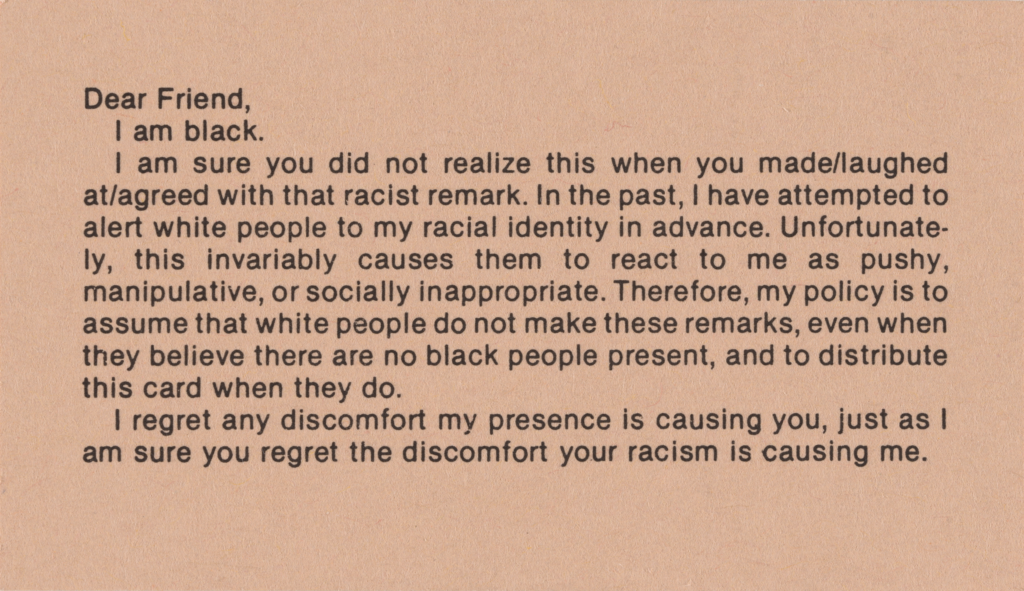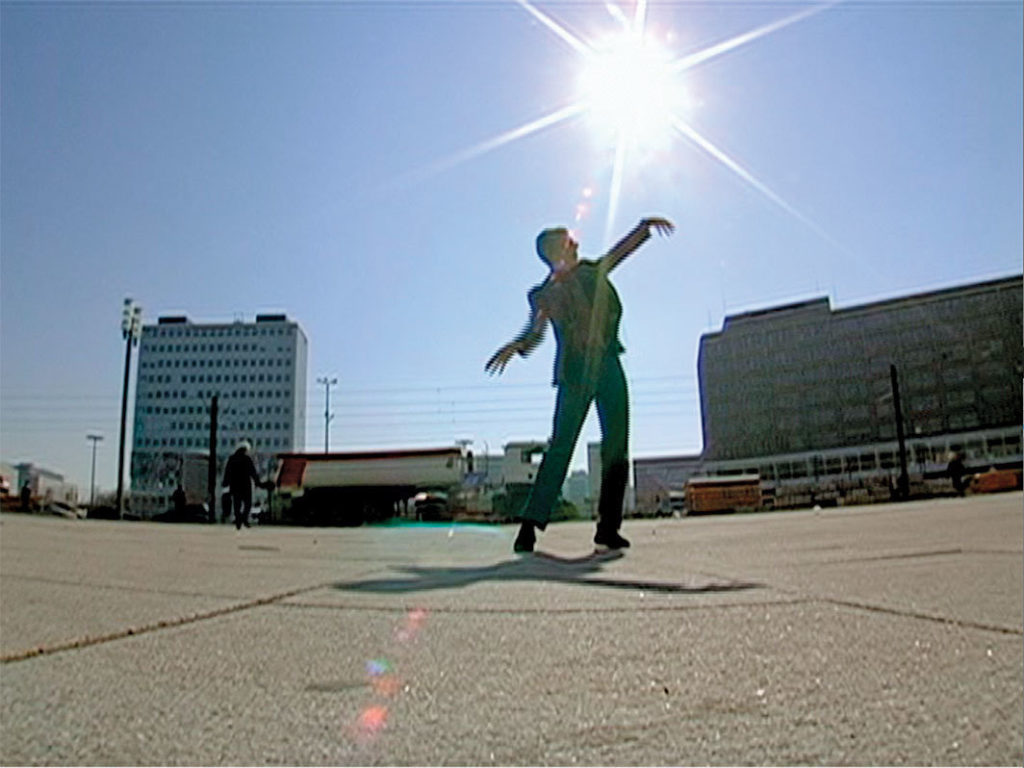Duality of Race: Examining Adrian Piper’s Work Through the Lens of Biracialism
Vanessa Gregorchik
July 19, 2021
In every aspect of Adrian Piper’s work, there exists a dichotomy: between artist or audience, intent or impact, reality or metaphor. Her sense of self has been historically split in half, or in even greater fragments, as she explores the space between academic and artist, insider and outsider, and black and white. To this end, Piper’s collection of work avoids categorization. In 2018, the Museum of Modern Art in New York City dedicated the largest exhibit space ever for a living artist to display Adrian Piper: A Synthesis of Intuitions 1965—2016. It featured 291 pieces of art from architectural drawings to photo montages, LSD paintings to time-based media. Piper’s work captures refusals, rebuttals, requirements, and negotiations that she asks of viewers to force against complicit silence. Piper refuses passing of all forms, and if the people surrounding her beg her to box herself into a single classification, she forces the same back to them.
Passing is a central idea and discussion that Piper provokes in her work. In relation to race, passing is the practice in which one is able to assimilate into a racial group that is different from their own. Piper uses the term in context with the United States, with the historical background of multiracial individuals passing as white to avoid racial discrimination during the Jim Crow era and beyond. Passing is a phenomenon that still exists in the 21st century, and one that is often seeped in shame, and dishonors one’s family. In Piper’s 1992 essay, “Passing for White, Passing for Black,” she details how trying to understand her relatives who have chosen to pass for white “has been one of the most difficult ethical challenges of my life,” one in which she doesn’t consider herself “to have made very much progress” (“Passing” 13). In exchange for economic freedom, greater access to job opportunities, and privileges and liberties of the white community, one must abandon the history and solidarity of the black community. In a nonpermanent way to explore passing’s transcending effects, Piper began a 1973 project titled Mythic Being in which she assumed a male identity and explored society through a new lens, one that reduced its level of “otherness” down one from black woman to black man. In the video Mythic Being she asks, “What would happen if there was a being who had exactly my history, only a completely different visual appearance to the rest of society? And that’s why I dress as a man.” She costumed herself with an Afro wig, mustache, reflective sunglasses, and a cigar hanging off the corner of her mouth. After day-long assimilations and explorations as this alter ego, Piper would document herself in disguise with photographic self portraits later etched with oil crayon. Piper’s manipulation to the gelatin silver format reimagines the traditional dodge and burn process typically involved in the processing of such images. Traditionally, to darken or lighten specific areas of the developing film image, photographers utilize the light in the darkroom to either expose or hide areas of the photograph. Piper, rather, used crayon over the processed image to manually isolate herself as the subject by darkening either the background or an aura around the “Mythic Being.” She also drew a cloud of white that resembles a speech bubble, a traditional comics convention to indicate a character’s dialogue, above her character to illustrate typographic mantras that she inscribed in her journals and performed to the public. The limitations with manually dodging and burning gelatin silver—and with the prints as a whole—is their eventual deterioration that leads their shades to fade. Piper’s work in defining the shadows and highlights preserves their characteristics and temporarily prevents the blacks and whites of the image to read as a singular grey—a process that she literally and metaphorically injects in several of her projects and self reflections on racial identification.
Typography remains a consistent character in Piper’s works across photography, performance art, and illustration. Whether hand-drawn or typewritten, language is inexplicably tied to Piper’s pieces. Like a script for a play, she uses words as the stepping stones for performance pieces and either audibly (like in Mythic Being) or in silence, they provoke the audience to react or disregard. In Catalysis III, Piper adorned a long-sleeve white blouse with a sign attached reading “Wet Paint.” She walked through the streets of New York without speaking, begging to tap into the audience’s unconscious desire to touch—to test their theory on whether or not her proclamation is true. Like famed Austrian performance artist Valie Export’s Tap and Touch Cinema (1968), in which Export invited passersby to touch her breasts through a curtained cube constructed over her chest, Piper offers herself as an object to her environment with a visual declaration that solicits touch. But unlike Export’s performance piece, no one touches Piper. Other differences include the artist’s skin color, racial identification, and site of the performance. Is it easier for strangers to touch a white woman’s body since they are surrounded by other white faces in a European city? Is the (outwardly) black body one that is only meant for private touch to the people of the United States? Regardless of the answers to either question, the audience’s reaction to Piper’s piece is another example of her quizzically uncategorizable medium. Export’s work reacted to medium of the cinema and through her facial expressions, in which she engaged the gaze of the viewer, broke the fourth wall—the space between audience and artist—that is typically hidden in male-produced pieces that feature the sexualization of women. She grins, laughs, or frowns to show bystanders or those who interact the consequences of their interactions. Piper remains stoic and uses her costume of the word to remain wordless. In comparing her work to that of a flâneur—a figure, typically male, who exists to simply walk within a city and merge into a crowd—James Trainor focuses on how Piper’s deadpan deliberation is key to her message. “The artist’s detachment and mobility seemed to deny the act’s interpretation as theatre,” he states, further distancing it from Export’s work. “Key to the event, it seems, was the uncategorizable and disorienting impact of what the street spectator was witnessing. The ambulatory nature of the confrontation was therefore essential in preserving the sense of hesitating bafflement and the fleeting, caught-on-the-fly aspect of the occurrence” (85).

While the last example of typography in Piper’s work showcased words in motion, the next example is more static. Piper explores the assertive power and permission of text through her calling cards. My Calling (Cards) are typographic pieces printed on top of business card-sized stock paper. Both their form and title mimic a visiting card: a physical note individuals would leave at homes to notify the occupant of their visit. Piper utilizes the calling card to both call out and conceal her reactions to racist and sexist remarks by strangers who misinterpreted either her intentions or identity. My Calling (Card) #1 (For Dinners and Cocktail Parties) is printed on burnt tan paper with black type overlaid, addressing the audience as “Dear Friend, / I am black. / I am sure you did not realize this when you made/laughed at/agreed with that racist remark…” My Calling (Card) #2 is a contrast, printed on light cream paper and explaining to the same “friend” that “I am not here to pick anyone up, or to be picked up. I am here alone because I want to be here, ALONE [sic]…” Despite its printed medium, the piece remains a performance. Its meaning is not activated until its circulation begins, even with a call to action present with the line “my policy is to assume that white people do not make these remarks…and to distribute this card when they do.” The final line assumes responsibility and regret (“I regret any discomfort my presence is causing you”) and extends the same assumption (“as I am sure you regret the discomfort your racism is causing me”) back to the viewer. To trace back the name—My Calling (Card)—one assumes that the medium of the card is perhaps variable since it is left in parenthesis and the true emphasis is on Piper’s calling. “Calling” is defined as the loud cries or shouts of an animal or person, or the strong urge toward a particular way of life or career or vocation; Piper is called to act even at settings of cocktail parties and dinner events when others are extended the luxury of not having cards at the ready, prepared to deal a deck or draw at any time. The physicality of the card “fights a stereotype by giving the offender a concrete experience of what it is like to be the object of one,” as Piper writes, without the need for Piper to speak. The exchange once more creates a dichotomy between giver and receiver, but this time remains muteless in order to reflect on the racist message that just took place—all catalyzed by an initial assumption or disregard of race.
To contrast the calling cards’ voiceless premise, Piper’s The Probable Truth Registry, from 2013–2017, relies on vocal promise. Much of Piper’s work has been influenced by her studies of Immanuel Kant, and in the Truth Registry, she attempts to retrace his process of defining the categorical imperative in order to represent his ideas to the everyday person. Piper creates a set of three new imperatives through the Truth Registry, and she studies if she can get her visitors to participate within a new social contract. Kant’s categorical imperative is defined as a way of “evaluating motivations for action” while Piper evaluates individuals’ motivation to produce action (Canbaz 406). The interactive exhibit was displayed at the Hamburger Bahnhof, a Berlin art museum housed within a former subway terminal. In the piece, the arches that surround the large, gold-brushed cylindrical booths are cathedral-like, yet cold, perhaps due to their utilitarian grey steel structure with no ornamentation. The flooring is made up of steel grey tiles that consume a vast blank space among the booths. Each station is surrounded by a split-circular grey wall that contributes to the ominous steel arch structure. On each wall, a gold embossed statement is displayed, including: “I will always be too expensive to buy; I will always mean what I say; I will always do what I say I am going to do.” These declarations make up the three principles with which viewers can agree or disagree, and if their reaction is the former, they are invited to provide their e-mail address and digital signature to join the registry of the “trustworthy,” a new society that pledges to uphold these ideals. At the conclusion of the exhibit, participants are promised a printed copy of the registry and the full list of others who pledged the same promise.
Within the principles, there is a compelling focus on—once again—the voice. The importance of visitors doing what they “say” makes up two-thirds of the imperatives, showcasing the significance of setting intentions and fulfilling them.
To bring back these ideas back to the Kantian idea of the categorical imperative, one tenant of his principles is the static application of the virtues despite the situation. The categorical imperative cannot change and must stay constant. Despite Piper’s ever-evolving medium of work, her messages and motivations stay central and consistent. It becomes easier to understand Piper’s positioning toward passing, even if it promised family members a brighter outlook in life, when viewed through a strictly Kantian lens.
And typography begins to take a backseat and moves from being the centerpiece of the artwork to being the commentary. Exploring self portraits to see the way Piper reflects on her own self image and manipulates different aspects to feel more or less like herself allows one to follow on the Kantian lens Piper has applied to her work. To begin, Piper’s Self Portrait Exaggerating My Negroid Features (1981) follows in style with Mythic Being, in which she has captured a slice of self and manipulated specific characteristics to assimilate first within a different gender group and now a different—or rather, further into one she is already a part of—racial group. This portrait presents the self as something that is mutable, reflecting the fluid process of racial identification. Through presenting black stereotypes upon her visage such as a widened nose, full lips, and frizzy hair, she destabilizes “the very concept of racial identity,” as Holland Cotter puts it. Piper places distance between visual representation and racial recognition, forcing the viewer to negotiate the ground that lies between and challenge their sense of identification. If Piper were to stand next to this self portrait, would one be more likely to identify her as black? Is exaggeration the only way one is able to rationalize her racial identity? .
Piper followed the 1981 piece with another portrait titled Self Portrait as a Nice White Lady in 1995, following Mythic Being once more in its path of identity manipulation but also medium manipulation. The work is a photograph altered with oil crayon that reintroduces the speech bubble motif that Piper toyed with in her 1973–1975 series. The background is colored blood red, introducing one of the only colors in her series of black and white photographs. I am interested in how the title of this portrait omits the term “exaggerated” as in the previous piece, curious if it is because Piper is able to pass for a white woman with far less difficulty than the identity of a black woman. In this portrait, is she still exaggerating? Or succumbing to what society so often assumes of her? In addition, the decision to capture the latter portrait as a photograph assumes a level of realism more distinct than in the former portrait, and hints that Piper’s physicality in a photograph is more similar to that of a “nice white lady.” The dialect in the speech bubble, as a departure from the Kantian declarations of Mythic Being, assumes an African American vernacular English tone that merges and satirizes the spaces between her identity as a black and white woman.
In addition to satirizing the space between black and white identification, Piper calls out the prominence and likelihood of black heritage in every individual. Through a video installation titled Cornered (1988), Piper directly addresses a viewer via a small television screen and informs them of the history of miscegenation and calls on them to confront their mixed heritage. In a literal manner of “turning the tables”–the installation features a table turned on its axis in front of the television screen–Piper reverses the so-called one-drop rule, which is often invoked to discriminate against mixed-raced individuals who have “one drop” of black blood, to showcase its fallibility. In the piece, she is literally “cornered” in the intersection of the two walls where the exhibit is placed but also metaphorically in the space between black and white. Throughout the 15-minute video, Piper displays two birth certificates, both belonging to her father, one in which he is identified as “white” and one in which he is “octoroon,” the antiquated term for someone who is one-eighth black.
In many of Piper’s former performances, the physicality of an object is to prove its existence. In this piece, the certificates prove that visual devices can be faulty. If this disparity exists between her black father’s physical record of existence, the document that issues his personhood, what’s to say that this disparity does not exist within yours? Another contradiction that exists within Piper’s performance is her assertion that her audience perceives her as white while she holds the same belief back at them. The audience for the piece remains white, casting the black spectator—the one who watches the show but never appears on the script—to the outside of the conversations that directly involve the fragmentation of their identity.

Piper has plenty of pieces where she breaks through the walls of identity those impose around her. Performance has been a key aspect to plenty of her work, but in Adrian Moves to Berlin 2007, one has the impression that not all of her pieces require an audience. In a video recorded by Robert Del Principe, Piper is seen dancing in Alexanderplatz, a public square in Berlin, after her decision to permanently move to the city upon discovering her placement on a TSA watch list of suspicious travelers. For most of Piper’s work, she seemed to struggle to choose between two or more identities—but this decision to remove herself from the United States seemed an easy one, consistent with her work criticizing government authority and verdicts. Distinct from her Mythic Being or Catalysis performances, no one stops to gawk, interact, or stare at Piper as she dances through the square. People simply glance or acknowledge and continue with their day. The stills of her performance are breathtaking: the fluid shape and movement of her limbs tell a story as clearly as her writing. She transitions away from being didactic to poetic and meditative, as though every micro-movement holds a meaning greater than the last. The still sun rays captured elevate her body to a state of transcendence, and though it was written 20 years prior, perfectly capture the sentiment from her 1987 essay “Flying”: .
I spring from the ground, executing high leaps, tour jetés, turns, somersaults, twists, and twirls. I float effortlessly through these figures, can stay suspended in the air for as long as I like. My ballet and modern dance teacher, Miss Copland, watches, transfixed (223).
The magisterial Synthesis of Intuitions exhibit ends with this looped recording, marking a finale to a floor filled with always shifting mediums and sizes and displays. The exhibit ends with a sense of unfiltered joy that escapes the battle with categorization that plagues her prior work. There was always an encounter or negotiation or question posed to the audience, and Piper was able to finally release that tension through dance.
In the summer of 2017 as a student studying abroad in Berlin, I made a promise that I will always be too expensive to buy, I will always mean what I say, and I will always do what I say I am going to do. When I discovered Piper’s work through the Probable Trust Agency at the Hamburger Bahnhof, I was just on the hinge of discovering the variety of mediums she has utilized to express her multiplicity of identities—yet another dichotomy Piper is always teasing and toying with. Through her work, I have seen my own anxieties surrounding racial identification—as a mixed-race woman who can pass for white—synthesized to the point of recognition. In her work, I can survey the perspective of both the artist and audience. This uncanny duality feels almost intentional—it is one more way for Piper to pursue a dichotomy of intent and impact, or black and white.

Even once the constant tension of negotiation is released, Piper moves forward with retirement. In a press release-style posting on her website, she announces, “Adrian Piper has decided to retire from being black. In the future, for professional utility, you may wish to refer to her as The Artist Formerly Known as African-American.” The announcement features a 2012 digital self portrait titled Thwarted Projects, Dashed Hopes, A Moment of Embarrassment. The portrait is visibly darkened over her skin, teeth, and wisps of her front bangs turning them either brown or orange. Overlaid on the image is typewritten text that explains for her 64th birthday, she has decided to “change my racial and nationality designations. Henceforth, my new racial designation will be neither black nor white but rather 6.25% grey, honoring my one-sixteenth African heritage.” I have chosen here to display the screenshot of the announcement from her website, which features a galactic image in the background due to their contrasting pairing. Both images feature a balance of shadows and highlights, but within the galaxy, there exists two prominent white circular patterns that potentially imitate the imagery of Piper’s eyes. Below the galactic highlights is a swirl of shadows that follow the pattern of Piper’s face. The relationship between the self portrait and galaxy is strong in both visual and metaphoric clues: Piper has spent her professional career exploring how her race affects her place in American and authoritarian structures, and at 64, after living in a different country for several years, she has resigned that battle. Piper is never able “to fully transcend these categories and the violence they inflict”—at least in a physical environment (Ro). But overlaid on a celestial silhouette, Piper hints at the world to come when she can shed the weight of her forced constellations and simply live.
Works Cited.
“Adrian Piper: A Synthesis of Intuitions, 1965–2016.” The Museum of Modern Art, New York. 2018.
Canbaz, Melissa. “Adrian Piper: The Probable Trust Registry.” ArtForum, vol. 17, 2017, pp. 406.
Cotter, Holland. “Adrian Piper: The Thinking Canvas.” New York Times, 2018.
Juno, Andrea. Angry Women. Juno Books, 1999.
Lammer, Elise and Karima Boudou. “Adrian Piper ‘The Mythic Being’ at MAMCO, Geneva.” Mousse Magazine, 2018.
Mercer, Kobena. ”Decentering and Recentering: Adrian Piper’s Spheres of Influence” in Adrian Piper: A Retrospective, 1999, pp. 56.
Pabst, Naomi. “Blackness/Mixedness: Contestations over Crossing Signs.” Cultural Critique, vol. 54, 2003, pp. 178-212.
Piper, Adrian in Out of Order, Out of Sight, vol. 1, Selected Writings in Meta-Art 1968–1992, 220.
Piper, Adrian. “Passing for White, Passing for Black.” Transition, vol. 58, 1992, pp. 4-32.
Robinson, Amy. “By/passing Identity: A Response to Women and Theatre 1992.” Theatre Topics, vol. 3, 1993, pp. 75-80.
Ro, Lori. “Adrian Piper has done it all – what now?” Gathering of the Tribes Magazine, 2019. https://www.tribes.org/web/2018/8/27/adrian-piper-has-done-it-all-what-now-lori-ro.
“The Mythic Being.” adrianpiper.com, updated by Adrian Piper, 1973.
Trainor, James. “Walking the walk: the artist as flaneur.” Border Crossings, vol. 22, 2013, pp. 82-92.
Vanessa Gregorchik is a designer and strategist in Louisville, Kentucky. Currently, she works at Upstatement where she helps people and publications tell their stories on and off the web. Previously she was with The Washington Post experimenting with design and technology. Vanessa cares about the way digital and physical spaces shape our communities.

